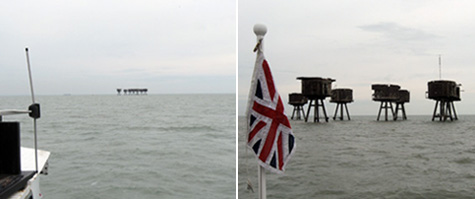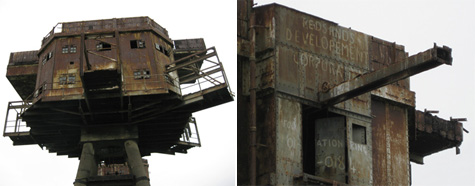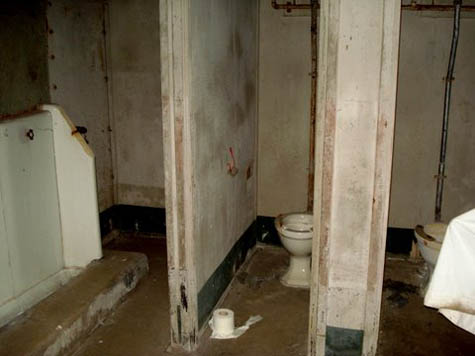A God-awful rendering has been released for a misguided plan to transform the amazing offshore megastructural war ruins of the Maunsell Towers into a luxury hotel.
Tag: Maunsell Towers
Maunsell Towers
 [Image: The Maunsell Sea Forts, photographed by Pete Speller, courtesy of Nick Sowers].
[Image: The Maunsell Sea Forts, photographed by Pete Speller, courtesy of Nick Sowers].
I missed an amazing opportunity the other week to visit the Maunsell Towers – aka the Maunsell Sea Forts – with Nick Sowers, author of an excellent Archinect school blog and one of my students from this summer’s studio down on Cockatoo Island in Sydney.
For the last year or so, Nick has been traveling around the world on a much-deserved John K. Branner Fellowship, documenting army bases, abandoned bunkers, and other sites of historical military interest. From South Korea to the Maginot Line, from classical war zones and medieval walled cities to “bunker recycling services” and D-Day, Nick’s itinerary is breath-taking. It is also, I hope, intriguing enough to catch the eye of future publishers or gallerists who might want to give Nick the space in which to break down all that he’s seen; there are very many of us who would love to learn more.
Of course, we could also hear more about his trip: Nick is acoustically-inclined, and he has been documenting the sounds of these militarized landscapes over on another blog he runs, called Soundscrapers.
 [Images: Photos by Nick Sowers].
[Images: Photos by Nick Sowers].
So Nick and his wife were in England the other week, and we unfortunately missed meeting up – but they managed to take a boat tour out to the Maunsell Sea Forts, iconic architectural structures in the Thames Estuary, inspirations for Archigram, and one of the few real-life buildings (if you can call them that) that gave me the idea to start BLDGBLOG. In fact, I’ve mentioned these places in lectures and I’ve posted about them on the blog before – but I’ve never had a chance to visit.
Nick’s photos, presented here, alongside photos by Pete Speller, will tell the story instead.

 [Images: Photos by Nick Sowers].
[Images: Photos by Nick Sowers].
As Underground Kent explains, “The Thames Estuary Army Forts were constructed in 1942 to a design by Guy Maunsell.”
Their purpose was to provide anti-aircraft fire within the Thames Estuary area. Each fort consisted of a group of seven towers with a walkway connecting them all to the central control tower. The fort, when viewed as a whole, comprised one Bofors tower, a control tower, four gun towers and a searchlight tower. They were arranged in a very specific way, with the control tower at the centre, the Bofors and gun towers arranged in a semi-circular fashion around it and the searchlight tower positioned further away, but still linked directly to the control tower via a walkway. All the forts followed this plan and, in order of grounding, were called the Nore Army Fort, the Red Sands Army Fort and finally the Shivering Sands Army Fort. All three forts were in place by late 1943, but Nore is no longer standing. Construction of the towers was relatively quick, and they were easily floated out to sea and grounded in water no more than 30m (100ft) deep.
They thus entered into the imaginations of speculative architects everywhere; they helped give visual shape to Archigram’s Walking City; and they continue to offer a kind of real-life spatial analogue for Constant’s New Babylon for anyone with access to a boat.
 [Image: The Maunsell Sea Forts, photographed by Pete Speller, courtesy of Nick Sowers].
[Image: The Maunsell Sea Forts, photographed by Pete Speller, courtesy of Nick Sowers].
Nick explained in an email that he visited the structures with Tony Pine, a “sound engineer” – i.e. pirate radio operator – who spent the afternoon “telling stories of the days in the 60s when Archigram came out to visit the structures, and also about incredibly cold winters when they burned the wood-fibre linings of the tower interiors to stay warm.”
Also along for the ride was Robin Adcroft, director of Project Redsand, who “describes himself as the caretaker of the structures.” Adcroft points out the genealogical importance of these structures:
The Thames Sea Forts are the last in a long history of British Marine Defences. The Army Anti Aircraft forts have played a significant role in post World War 2 developments. Notably in offshore fuel exploration and drilling platforms. The successful rapid deployment of the Maunsell Forts soon after led to the construction of the first offshore oil platform in the Gulf of Mexico in the late 1940s.
Both conceptually and materially, the Maunsell Towers have an architectural legacy that seems oddly under-explored.


 [Images: Inside the forts; photos by Pete Speller, courtesy of Nick Sowers].
[Images: Inside the forts; photos by Pete Speller, courtesy of Nick Sowers].
But “it’s interesting,” Nick adds: “no one actually owns these things.”
Apparently the transport authority wanted to give Project Redsand a deed but they declined it, not wanting the liability. A ship crashed into Shivering Sand (an outpost which is visible from Redsand) in the 60s, taking out one of the towers and killing two maintenance personnel. Red Sand is not actually in the shipping lane, but it is very much a hazard. The original 1/4 inch plate steel is rusting through to a paper thickness. We had to wear hardhats when the boat pulled in next to the structures.
Project Redsand has more information about efforts to preserve the forts – and they link to this short YouTube video in which you can see how these clustered towers might be stabilized and maintained for generations to come.





 [Images: Photos by Pete Speller, courtesy of Nick Sowers].
[Images: Photos by Pete Speller, courtesy of Nick Sowers].
Meanwhile, be sure to follow Nick Sowers’s slowly-ending travels around the militarized world on his Archinect blog – and he can also be found on Twitter.
Katrina 3: Two Anti-Hurricane Projects (on landscape climatology)
Project 1: “How do you slow down a hurricane?”
In the June 2005 edition of The Economist Technology Quarterly (subscription required), we read about Moshe Alamaro, “a scientist at the Massachusetts Institute of Technology, [who] has a plan. Just as setting small, controlled fires can stop forest fires by robbing them of fuel, he proposes the creation of small, man-made tropical cyclones to cool the ocean and rob big, natural hurricanes of their source of energy. His scheme, devised with German and Russian weather scientists and presented at a weather-modification conference in April, involves a chain of offshore barges adorned with upward-facing jet engines.”

“Each barge creates an updraft, causing water to evaporate from the ocean’s surface and reducing its temperature. The resulting tropical storms travel towards the shore but dissipate harmlessly. Dr Alamaro reckons that protecting Central America and the southern United States from hurricanes would cost less than $1 billion a year. Most of the cost would be fuel: large jet engines, he observes, are abundant in the graveyards of American and Soviet long-range bombers.”
The creation of manmade tropical micro-storms, using heavy, greenhouse gas-burning jet engines towed through the waters of the equatorial Atlantic on what are, for all intents, artificial islands… is really a pretty ridiculous idea.
Yet it reminds me of a long-standing BLDGBLOG project that has otherwise gone unpublished. Till now:
Project 2: The Aeolian Reef
In Virgil’s *Aeneid*, translated by Robert Fitzgerald, we read about “Aeolia, the weather-breeding isle”:
“Here in a vast cavern King Aeolus
Rules the contending winds and moaning gales
As warden of their prison. Round the walls
They chafe and bluster underground. The din
Makes a great mountain murmur overhead.
High on a citadel enthroned,
Scepter in hand, he molifies their fury,
Else they might flay the sea and sweep away
Land masses and deep sky through empty air.
In fear of this, Jupiter hid them away
In caverns of black night. He set above them
Granite of high mountains – and a king
Empowered at command to rein them in
Or let them go.” (Book 1, Lines 75-89)
Thus: BLDGBLOG’s Aeolian Reef.
To be fair, this all began as nothing more than an idea for a new, artificial island that would be added to the Cyclades archipelago in Greece. It would be somewhere between Constant’s Babylonic mid-sea pavilion –

– the Maunsell Towers –

– and a kind of massive, off-shore, geotechnical saxophone.
Full of vaulted tubes and curved ampitheaters – and complex twists through a hollow, polished core – this modern Aeolia, an artificial island, would produce storms (and even, possibly, negate them).
A modern Aeolia, in other words, would be a “weather-breeding isle” – or a “weather-cancelling isle,” as the case may be: because then there was Katrina.
What would happen, I thought, if you built a manmade, weather-cancelling isle that could *stop hurricanes from forming*? I realized, of course, immediately, that you would actually need hundreds of these tuba-like, anti-hurricane islands – even an entire manmade archipelago of them – because the atmospheric paths of storms are far too unpredictable.
You would need, that is, an Aeolian Reef.
The Aeolian Reef – and the current author, who cannot draw, hint-hint, would *love* to collaborate with any BLDGBLOG readers who want to illustrate some of these things – would consist of oil derrick-like platform-islands built in climatologically influential patterns throughout both the Gulf of Mexico and the larger, equatorial Atlantic.
The Aeolian Reef would: 1) trap and redirect high-speed winds from any burgeoning tropical storms and hurricanes, thus preventing them from actually forming; 2) provide incredibly exciting meteorological/atmospheric observation platforms far out at sea; and 3) be readily exportable to other countries and other climates, for other purposes – land-based anti-tornado clusters, for instance.
This would therefore take the subject of an earlier BLDGBLOG post a few steps further: it would use architecture, or landscape architecture, as a way to directly influence, change, or redirect the climate.
It would, in short, be *landscape climatology*.
One could imagine alternative uses, of course; even a computer glitch or global supervillain who rearranges all the internal valves of the Aeolian Reef to generate the mother of all hurricanes… in which case the Reef would be something of a national security threat.
This thread continues in Katrina 1: Levee City (on military hydrology); and Katrina 2: New Atlantis (on flooded cities).
Car park picturesque and the Texas tower

On a site that is rather amazingly drenched with typos, misspellings, and other grammatical errors, we found this call for developing a car park picturesque, or “landscaped tarmac for leisure” – surely the post-human car park could be retroverted for this…?
Meanwhile, for all you Maunsell Towers fans –


– there’s the Texas tower: 75 miles east of New Jersey, though now collapsed into the sea, it was “intended to provide advance warning of enemy air attacks,” as “part of the Distant Early Warning system (DEW line) encircling the United States and Canada.” It collapsed into the sea, however, and killed everyone on board. Archigram meets James Cameron’s Abyss.


So I’m writing this at the beginning of a month-long James Bond marathon on AMC-TV, and am thinking, in this context, how all of Bond’s villains seem really to be renegade techno-architectural contractors of some sort: you have that fake volcano movie, the hollow high-tech island of Dr. No, that stupid ice-city of the last (please!) Pierce Brosnan Bond, and what else was there – oh, Moonraker –


– in a particularly aerospatial moment of villainous ambition. In any case, then it occurred to me: that’s exactly what Osama bin Laden is/was – he’s a contractor. He built highways.
Plus ça change: he’s an ultra-rightwing Bond villain.
Maunsell Towers Sea Forts
Speaking of Gunkanjima Island… There’s also the Maunsell Towers:


“The [Maunsell Towers] Thames Estuary Army Forts were constructed in 1942 to a design by Guy Maunsell, following the successful construction and deployment of the Naval Sea Forts. Their purpose was to provide anti-aircraft fire within the Thames Estuary area. Each fort consisted of a group of seven towers with a walkway connecting them all to the central control tower.” Constant’s Babylon meets the economic mobilization of WWII. These look like a cross between the Empire’s attack-convoy robot-walker things in *The Empire Strikes Back* and, yes, Constant’s Babylon:



As such, these are dying to be used in a film.
Another site verges on the illiterate, but it’s clearly enthusiastic, and explains the towers’ construction.

